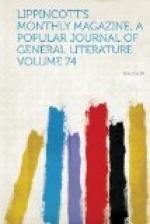Little by little, through divers probations, we begin to feel ground under our feet. We have our likes and dislikes, our favorite masters, pictures and statues, which are like old friends. Instead of weariness, vexation and a vain effort to comprehend, a delightful sense of repose and coming pleasure steals over us as we enter a gallery. The lovely forms, the noble composition, the delicious color minister to us, mind and body, and soothe us like music or the smile of Nature; and the plastic arts have this advantage over music, that they are impersonal. We cannot identify ourselves with what moves us in painting or sculpture or architecture: on the contrary, it lifts us out of ourselves, away from our griefs and cares, instead of giving them a more intense and poignant expression, which at some moments is all the divinest music seems to do. Their influence is always benign and serene, and we may always have recourse to it, while the secrets of Beethoven, Mendelssohn, Chopin, Schumann lie hidden between leaves, in the keeping of crabbed little hieroglyphs, and a voice, an instrument, or perhaps an orchestra, is needed to reveal them. The picture, the statue, has no secrets but open secrets. You stand before it, and the very soul and essence of it comes softly forth and breathes upon yours. Oh moments of delight, when we lose ourselves in the soft Arcadian mood of Claude Lorrain, in the cool, tranquil revery of the Dutch landscape-painters, in the giant impetuosity of Tintoretto, in the rich, warm sensuousness of Titian, in the glowing mystery of Giorgione, in the calm, profound devoutness of the early Flemings, in the religious rapture of the early Italians! It needs no jot of technical knowledge for this, however much that may enhance our enjoyment, as it undoubtedly must. But the inspiration of a work of art may be felt by any one.




